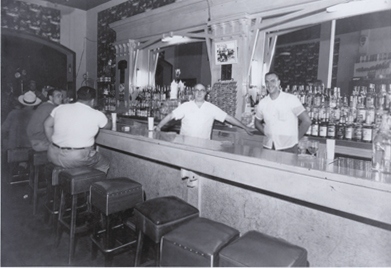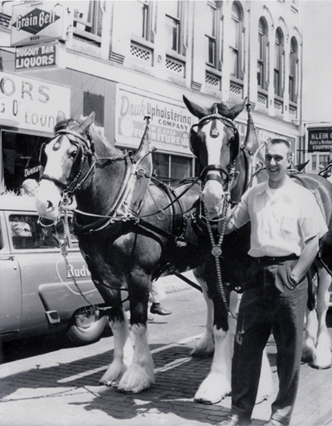The Dugout Bar
206 Third Street South, Minneapolis (1940? – 1959)
| The Dugout was unlike any other bar at the time, as it served an almost exclusively queer clientele in downtown Minneapolis. It was a popular hangout for veterans of the Second World War.(1)
As its name implied, the bar's masculine patrons were more apt to discuss baseball statistics than topics that related to their sexual preferences. Queer women possibly joined men at the Dugout, but their participation was socially and legally restricted.
|

Interior photo of the Dugout shortly before demolition. Image donated by Mark A. Morrill, the owner's grandson. Courtesy of the Jean-Nickolaus Tretter Collection. |
More vocal men, effeminate men, and the upper-class frequented the Viking Room in the old Hotel Radisson on 7th Street.
The Dugout sat in the seedy backwaters of the old Gateway District—Minneapolis’ longtime locus of prostitution. An anti-prostitution law (ironically) prevented women from entering bars without a male escort, thus lesbian couples were forbidden from using bars as sites of socialization.(2)
 Exterior photo of the Dugout and the bar's owner on Third Street South. Photo dontated by Mark A. Morrill, courtesy of the Jean-Nickolaus Tretter Collection. |
Of course, this was not always the Gateway’s case. 50 years before, the Dugout’s building was part of Minneapolis’ epicenter. Its site was part of old Harmonia Hall, a largely-forgotten 19th century auditorium for the city’s large German population.(3)
|
The Dugout was part of the roundly-criticized Gateway Urban Renewal Project. The city of Minneapolis cleared the entire block and it remained a parking lot for 19 years. 255 Avenue South—an office block—occupies the site, and it is part of the Wells Fargo Campus.
(1)Tretter, Jean-Nickolaus. Interview with the author, 10/25/09.
(2)Enke, Anne. Finding the Movement: Sexuality, Contested Space, and Feminist Activism. Durham, N.C.: Duke University Press, 2007. Page 40.
(3)Based on a comparison of the photographs on this page with photographs of Harmonia Hall: http://collections.mnhs.org/visualresources/Results.cfm?Page=1&Keywords=harmonia%20hall&SearchType=Basic&CFID=16026573&CFTOKEN=40085628]
(4)Rosheim, David L. The Other Minneapolis, or The Rise and Fall of the Old Gateway, Minneapolis' Skid Row. Minneapolis: Andromeda Press, 1978.
Part of Minneapolis/St. Paul, MN: 100 Queer Places in Minnesota History, (1860-1969), (1969-2010)